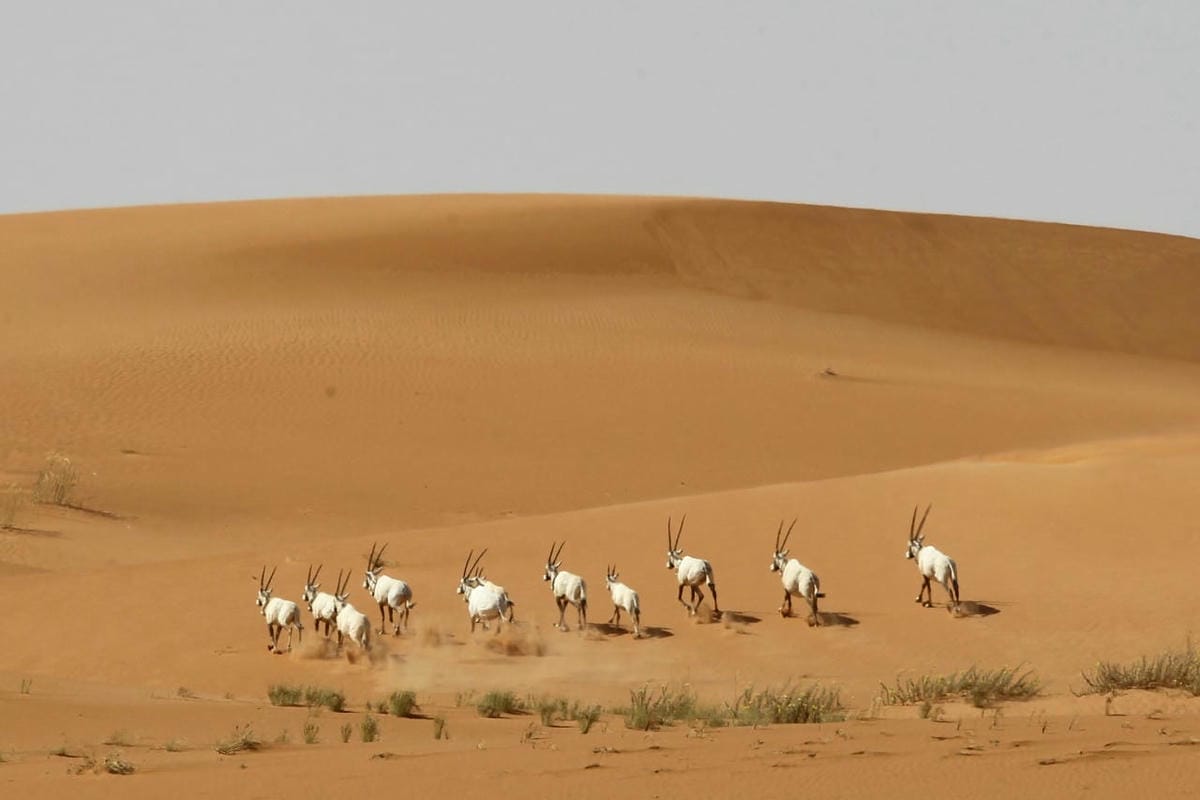
‘Uruq Bani Ma‘arid
The protected area is located inNajran and Riyadh Regions
Total Area12693 km²
IUCN categoryVI
Protected AreaThe protected area is in the western part of Ar-Rub' al Khali, the greatest expanse of windblown sand on Earth, where its dunes ride up on the southern end of the 1,000 km long limestone escarpment of Jabal Tuwayq. Their intersection gives rise to an extraordinary spectrum of juxtaposed contrasts and a panorama of Arabia’s largest linear dunes, along with inter-dunal corridors, well-vegetated eastward-flowing wadis, and the rocky Tuwayq Escarpment. Today, the protected area is the only place in the world where herds of Arabian oryx live freely without any human intervention , which led to listing it as a natural World Heritage in the UNESCO.
Notable plant speciesApproximately 88 plant species have been documented within the reserve. The sand dunes support distinctive endemic plants of Ar-Rub‘ al-Khali, which are adapted to its extreme aridity, such as Calligonum crinitum sbsp. arabicum, Cornulaca arabica, Tribulus macropterus var. arabicus, and Limeum arabicum. The escarpment supports Vachellia tortilisand species that are rare in hyper-arid regions, such as myrrh, Moringa peregrina, and an endemic form of Ziziphus spina-christi.
Notable animal speciesthe protected area provides extensive habitats for endemic and threatened species such as the Arabian oryx, Arabian sand gazelle, Arabian mountain gazelle, sand cat, Rueppell’s sand fox, Malpolon moilensis, sand boa, and sand skink, as well as for the Arabian hare, lappet-faced vulture, Asian houbara, and desert monitor lizard.
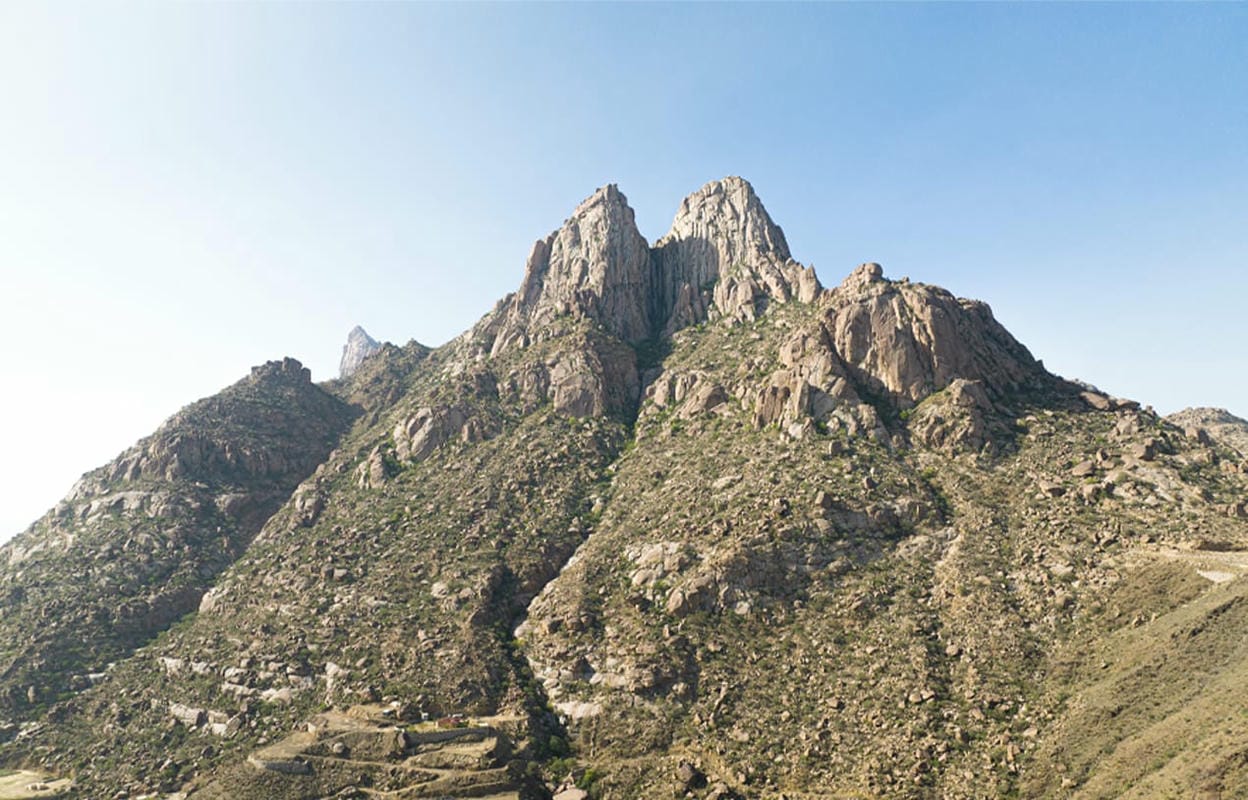
Jabal Shada al-A‘la
The protected area is located inAl-Baha Region
Total Area77 km²
IUCN categoryII
Protected AreaJabal Shada al-A'la lies southwest of Al-Baha city, in the northwestern part of al-Makhwah Governorate. The mountain is an outlier of the Sarawat Mountains to their west, and it rises some 2200 meters above sea level. The granite highlands are carved by steep ravines that hold dense groves of valley forest. The protected area is on Saudi Arabia’s Tentative List of World Heritage Sites.
Notable plant speciesApproximately 493 plant species have been documented within the reserve. A quarter of Saudi Arabia’s plant species have been recorded in this small-scale protected area, the most notable of which include Senegalia asak and Adenium obesum, Breonadia salicina, East African juniper, wild olive, wild jasmine, Nuxia oppositifolia, Dodonaea viscosa, Ziziphus mucronata, and Ziziphus spina-christi. Vachellia johnwoodii is endemic, dragon trees are endangered, and several Aloe species are endangered and endemic.
Notable animal speciesThe protected area is home to Arabian wolf, Blanford's fox, caracal, striped hyena, white-tailed mongoose, small-spotted genet, Indian crested porcupine, rock hyrax, and Hamadryas baboon. The Arabian leopard was previously recorded in the reserve.
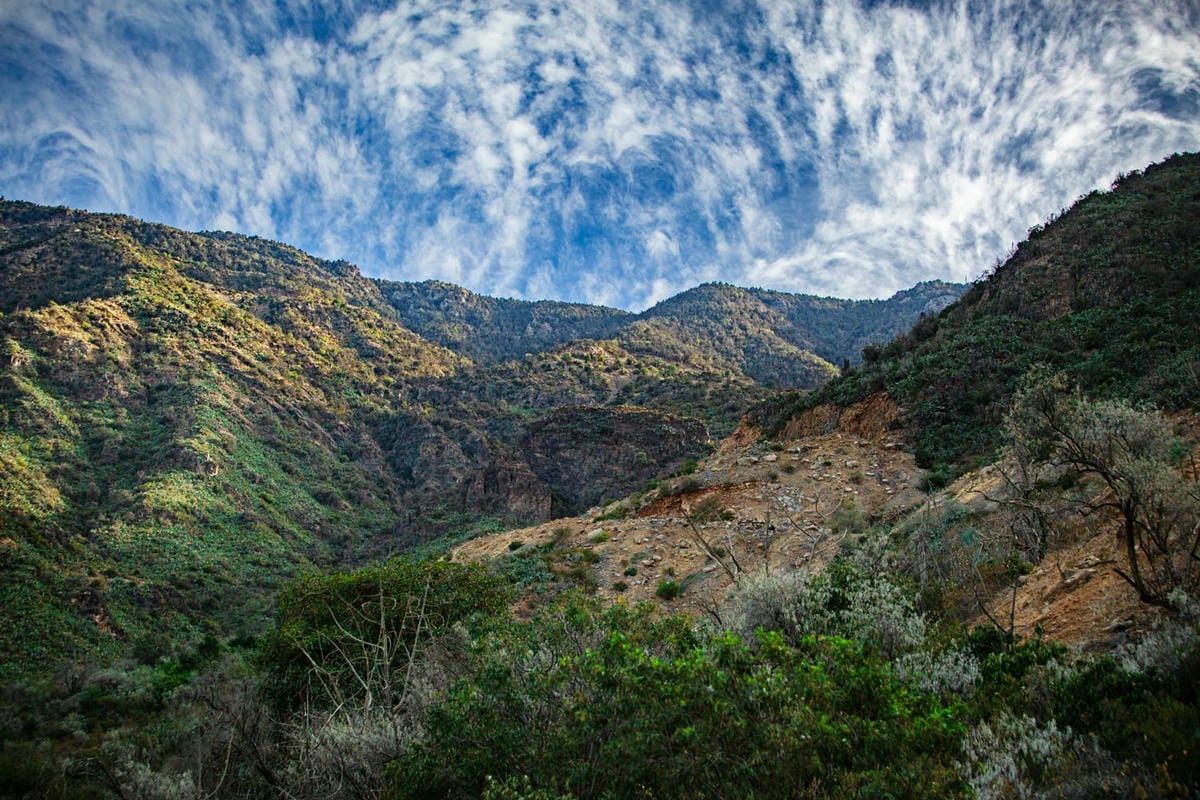
Jurf Raydah
The protected area is located in‘Asir Region
Total Area10 km²
IUCN categoryIV
Protected AreaOne of the smallest protected areas in Saudi Arabia, Jurf Raydah occupies the steep slopes of the Sarawat Escarpment, adjacent to the Kingdom’s highest summit at over 3,000 meters above sea level. Its distinctive topography, together with one of the highest recorded rainfall rates in the Kingdom, heavy fog, and rich organic soils, contribute to the presence of a distinctive cloud forest habitat and a high diversity of flora and fauna.
Notable plant speciesApproximately 348 plant species have been documented within the reserve. Many plant species have been recorded in the protected area, among them East African juniper, wild olive, African hackberry, Nuxia oppositifolia, Teclea nobilis, Maesa lanceolata, Tarchonanthus camphoratus, Pittosporum viridiflorum sbsp. arabicum, Halleria lucida, Euryops arabicus, and Dodonaea viscosa, as well as several Vachellia species and Ziziphus spina-christi.
Notable animal speciesThe protected area contains a variety of animals, such as the Asir magpie, Arabian waxbill, Yemen serin, golden-winged grosbeak, Arabian partridge, Philby’s partridge, Arabian woodpecker, Yemen linnet, Hamadryas baboon, Arabian wolf, striped hyena, Arabian red fox, caracal, wild cat, rock hyrax, ratel (honey badger), Indian crested porcupine, Egyptian spiny mouse, Geoffroy’s bat, and the Ethiopian epauleted fruit bat.
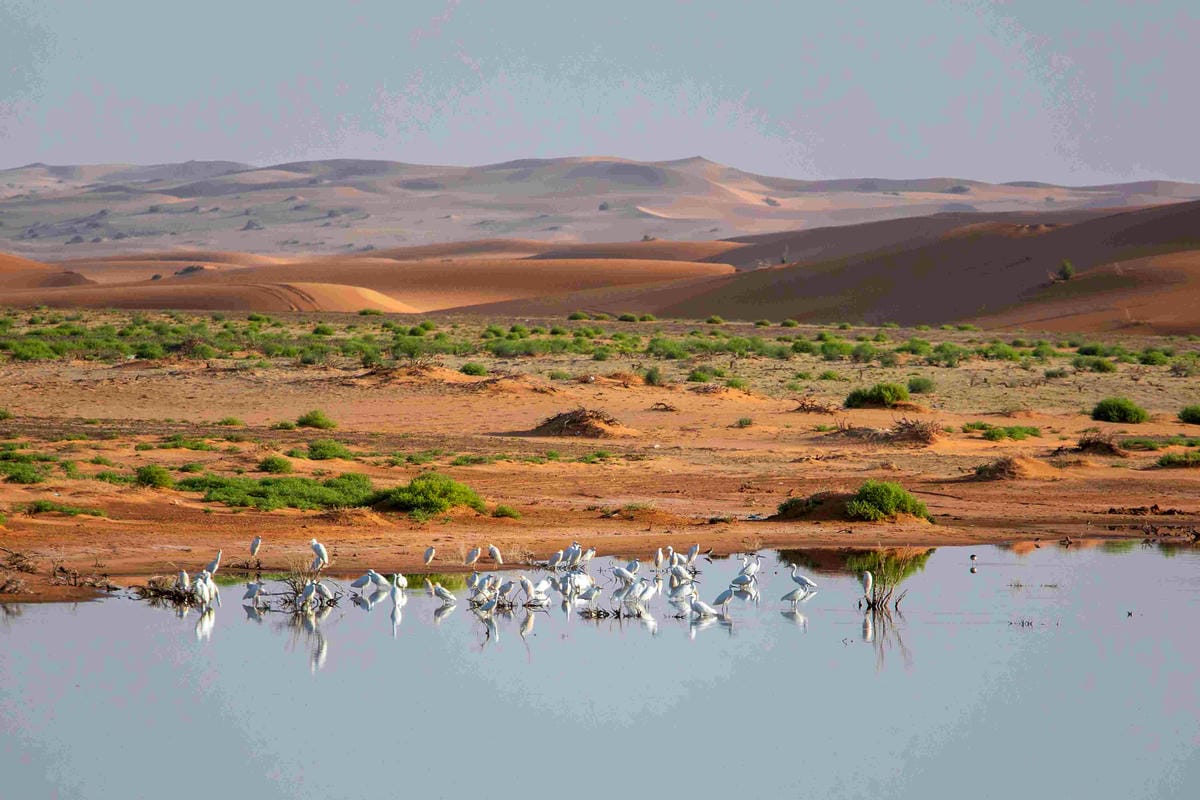
Nafud al-‘Urayq
The protected area is located inAl-Qasim and Riyadh Regions
Total Area2034 km²
IUCN categoryVI
Protected AreaSome 150 kilometers southwest of the cities of Al-Qasim, Nafud al-‘Urayq is a strip of sand dunes that represents the central nafuds ecosystem type. In previous centuries, it was part of Hima 'Iibil Alsadaqa were protected during the reign of Caliph Omar ibn al-Khattab, one of the great historical himas (traditional protected areas) of central Arabia and was used to pasture camels devoted to charity. The protected area includes a few granitic and metamorphic rock outcrops on the eastern edge of the sands.
Notable plant speciesThe predominant plant community in the northern and central parts of the protected area, relatively dense stands of Haloxylon persicum are found, while Haloxylon salicornicum and scattered Calligonum comosum predominate in the south. Vachellia tortilis and Lycium shawii grow in drainages with the grass Panicum turgidum, while the grass Stipagrostis plumosa grows in rocky areas and on plains.
Notable animal speciesThe Arabian wolf, Arabian red fox, Rueppell’s sand fox, ratel (honey badger), little owl, spiny-tailed dhabb, Felis margarita, Felis lybica, and sand viper are found ,and it’s a transit area of the migratory Houbara bustard in the protected area.
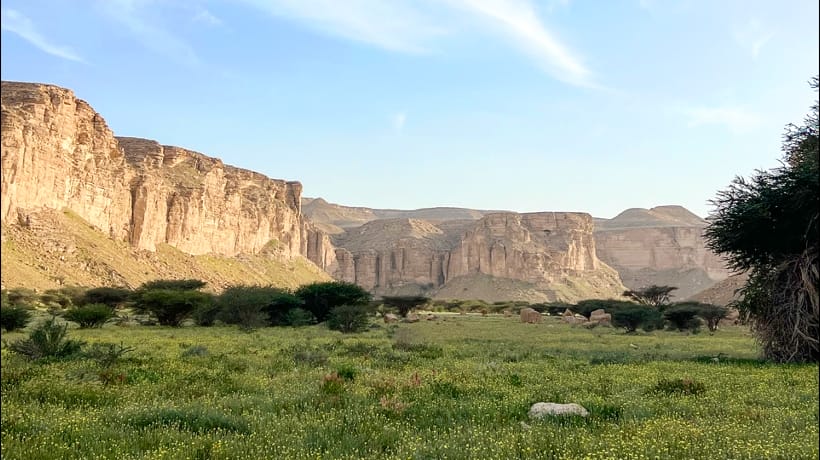
Ibex Protected Area
The protected area is located inRiyadh Region
Total Area1842 km²
IUCN categoryII
Protected AreaThe Ibex protected area is the wildest part of the Tuwayq Escarpment, south of Al-Hariq and west of Hawtat Bani Tamim, 180 km south of Riyadh. It is a large, rugged plateau, dissected by canyons and ravines, with a few sandy areas. The western edge of the escarpment reaches a maximum height of 1,097 m.
Notable plant speciesApproximately 268 plant species have been documented within the reserve. The protected area contains acacias, such as Vachellia tortilis, V. raddiana, and V. flava, as well as Maerua crassifolia and Ziziphus spina-christi, in the major drainages, along with the shrubs Lycium shawii, Convolvulus infantispinosus, Ochradenus baccatus, and Ochradenus arabicus, and the grasses Panicum turgidum, Cenchrus ciliaris, and Stipagrostis plumosa.
Notable animal speciesThe protected area is home to the largest population of Nubian ibex in the Kingdom, reintroduced Arabian mountain gazelle, and rock hyrax, Arabian wolf, Blanford's fox, Arabian red fox, Rueppell’s sand fox, spiny-tailed dhabb, desert monitor lizard, diadem snake, Burton’s carpet viper, and Oman toad. Among the notable birds are the griffon vulture, lappet-faced vulture, and sand partridge.
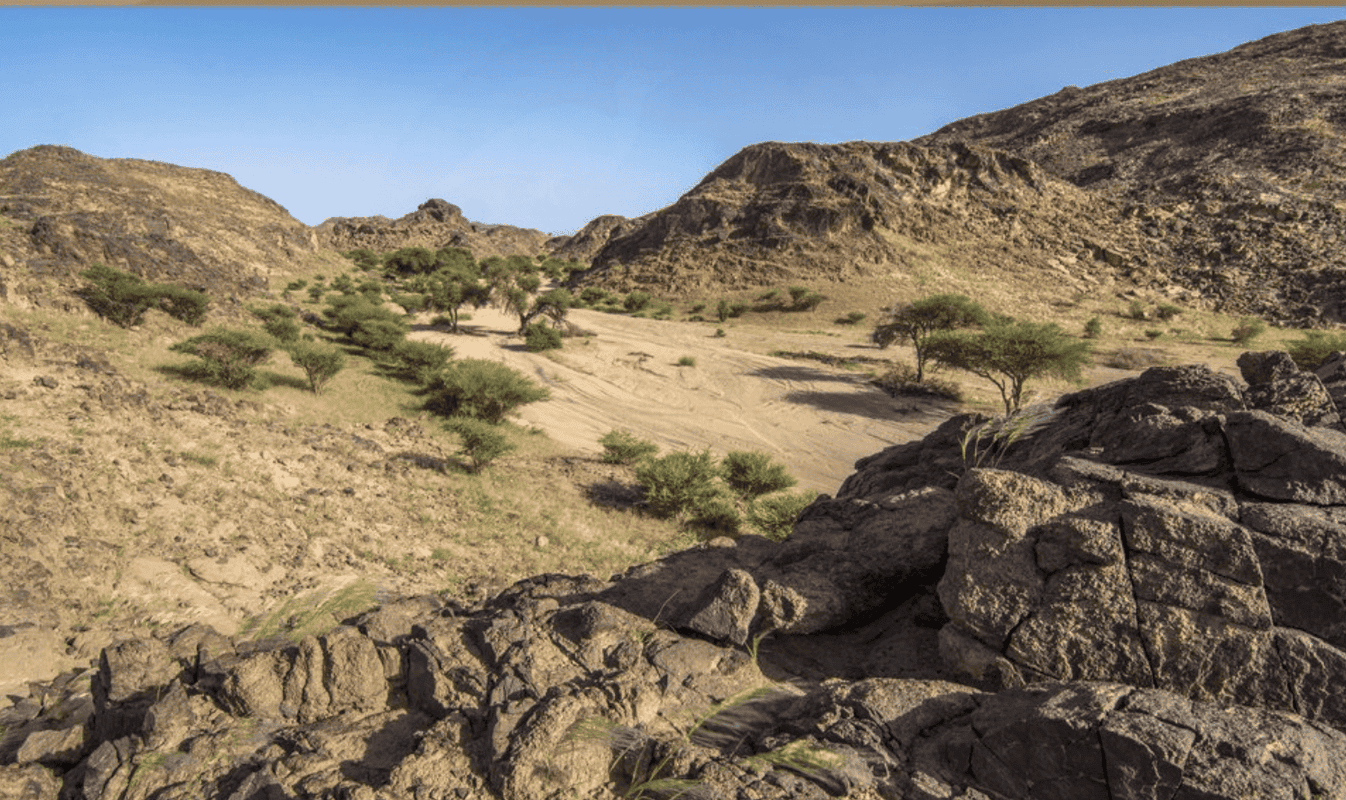
Majami‘ al-Hadb
The protected area is located inRiyadh and Makkah Regions
Total Area1181 km²
IUCN categoryVI
Protected AreaThe protected area is located about 125 kilometers east of the city of Ranyah. It is characterized by pale granite exfoliation domes, known as hadb in Arabic, as well as dark metamorphosed volcanic hills and sandy desert plains. The runoff from the smooth, impermeable granite domes supports some of the densest and most diverse plant communities in south-central Arabia.
Notable plant speciesThe plant communities are dominated by the acacias Vachellia tortilis, V. raddiana, V. flava, V. oerfota, with Maerua crassifolia and shrubs of Lycium shawii and Haloxylon salicornicum and the grasses Panicum turgidum, Cenchrus ciliaris, Cymbopogon schoenanthus, and Stipagrostis plumosa. Species more characteristic of the Sarawat mountains include Ziziphus spina-christi and Moringa peregrina trees.
Notable animal speciesThe protected area is home to the Arabian wolf, ratel (honey badger), Rueppell’s sand fox, Arabian hare, rock hyrax, sand partridge, golden eagle, and spiny-tailed dhabb. Arabian oryx, Arabian mountain gazelle, Arabian sand gazelle, caracal, striped hyena, and ostrich are known to have previously inhabited the reserve.

Sija and Umm ar-Rimth
The protected area is located inMakkah and Riyadh Regions
Total Area6,523 km²
IUCN categoryVI
Protected AreaThe protected area is in the central western region of Saudi Arabia and is contiguous with the northern and eastern boundaries of Imam Saud bin Abdulaziz Royal Reserve. It lies on the Arabian Shield and is a gently undulating sandy plain with low hills and outcrops of granitic and metamorphic rock.
Notable plant speciesApproximately 89 plant species have been documented within the reserve. Haloxylon salicornicum (rimth in Arabic) is predominant over extensive areas with relatively deep sandy soils, hence the name Umm ar-Rimth. Trees and shrubs of Capparis decidua (Forssk.), Vachellia tortilis, Vachellia flava, Maerua crassifolia, and Lycium shawii are widespread, along with the rare herb Ajuga arabica and the grasses Lasiurus scindicus, Panicum turgidum, Stipagrostis plumosa, and Cymbopogon schoenanthus.
Notable animal speciesThe protected area is inhabited by Arabian wolf, Arabian red fox, Rueppell’s sand fox, sand cat, wild cat, ratel (honey badger), desert hedgehog, lesser jerboa, lappet-faced vulture, Asian houbara, chestnut-bellied sandgrouse, Cursorius cursor, desert monitor lizard, spiny-tailed dhabb, eastern sandfish skink, and the usual agamids, lacertids, geckoes and snakes of central Arabia.
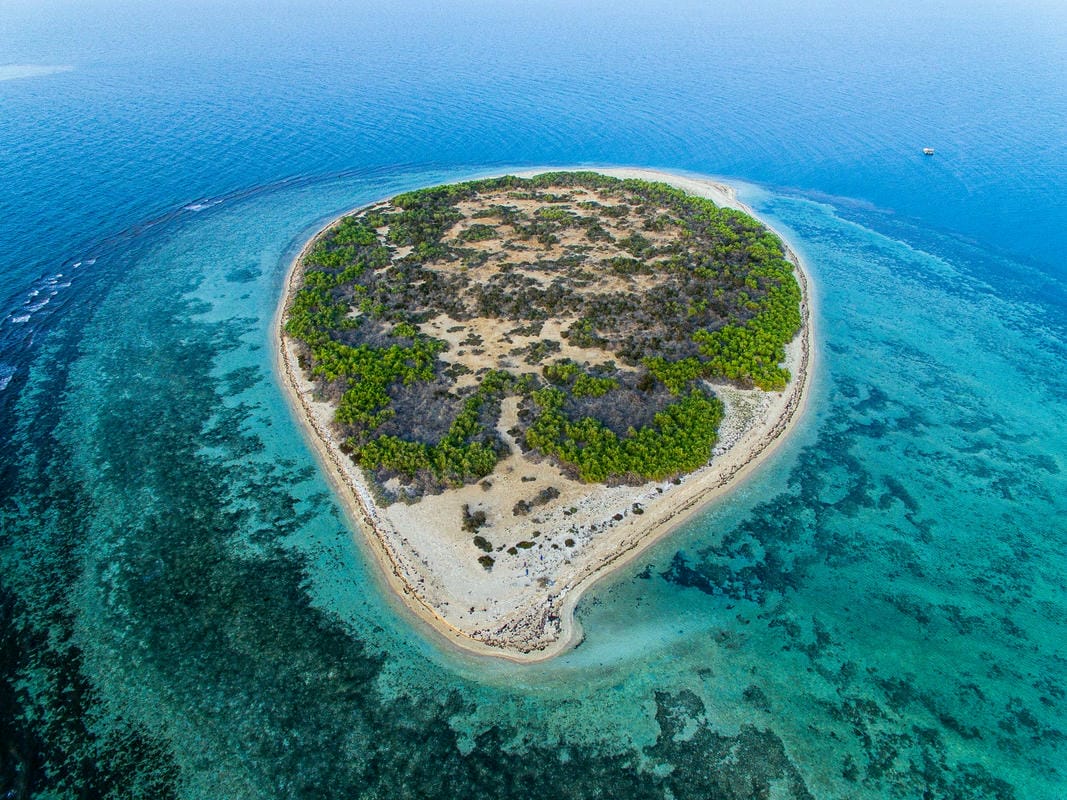
Juzur Umm al-Qamari
The protected area is located inMakkah Region
Total Area4.03 km²
IUCN categoryIa
Protected AreaThe protected area is in the southwest of the Kingdom in the Red Sea. It consists of two islands: Umm al-Qamari al-Barraniyah and Umm al-Qamari al-Fawqaniyah. It was named Umm al-Qamari for the large flocks of African collared doves that it harbors, especially during spring and summer. The islands are composed of coral limestone with an average height of 3 meters above sea level, and white coastal sand. A healthy coral reef near Umm al-Qamari al-Barraniyah Island harbors reef fishes and marine invertebrates.
Notable plant speciesApproximately 12 plant species have been documented within the reserve.The plant communities are made up of Salvadora persica, three Suaeda species, Atriplex farinosa, Zygophyllum album, Z. simplex, Cleome brachycarpa, and Cyperus conglomeratus.
Notable animal speciesUmm al-Qamari is an Important Bird Area. It harbors the largest colony of swift tern reported in the Red Sea, as well as lesser crested tern, brown booby, Eurasian spoonbill, cattle egret, western reef heron, osprey, sooty gull, white-eyed gull, great white pelican, pink-backed pelican, Kentish plover, and African collared dove. Fishes include bluespotted stingray, blacktip reef shark, blue trevally, potato grouper, yellowbar angelfish, barracuda, and a diversity of marine invertebrates.
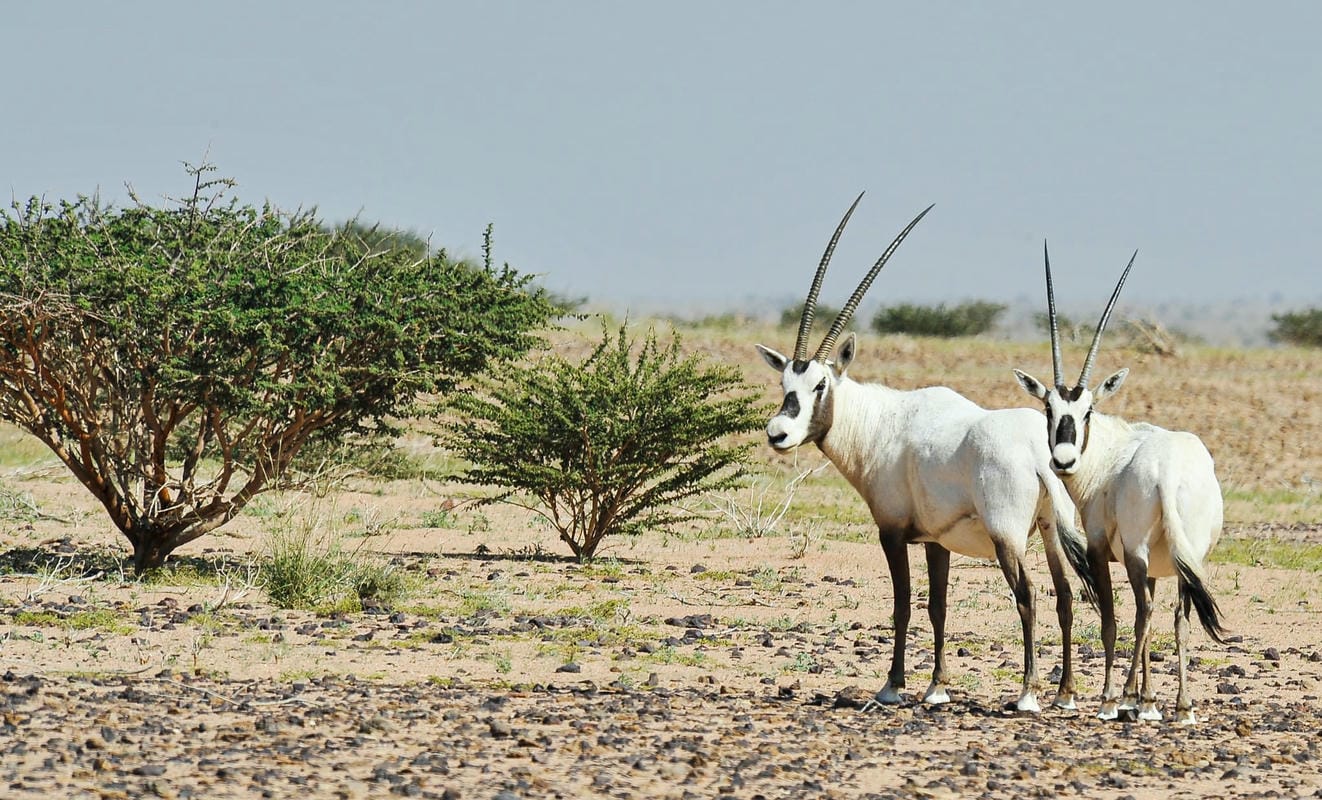
Imam Saud bin Abdulaziz Royal Reserve
The protected area is located inMakkah Region
Total Area2,240 km²
IUCN categoryIV
Protected AreaThe Royal Reserve is about 170 km northeast of the city of Taif, The reserve is located between the governorates of Al-Kharmah and Al-Muwayh and the center of Dhalm, which is administratively affiliated with Makkah Al-Mukarramah region. It is on the Arabian Shield and is a gently undulating sandy plain with basalt hills in the west and granite outcrops in the north. Unlike most other protected areas in the Kingdom, it is fenced and serves as a natural laboratory to reintroduce captive-bred herds of threatened species, and to monitor the success of their reintroduction.
Notable plant speciesApproximately 198 plant species have been documented within the reserve. The vegetation of the reserve consists of a desert savanna of Vachellia tortilis and other Vachellia species and Maerua crassifolia, with an understory of Lycium shawii and other shrubs, the perennial grasses Panicum turgidum, Lasiurus scindicus, and Octhochloa compressa, and the rare herb Ajuga arabica.
Notable animal speciesArabian oryx, Arabian sand gazelle, Arabian mountain gazelle, Asian houbara, ostrich, Lepus capensis, and Arabian hare have been successfully reintroduced to the reserve. The reserve also holds natural populations of Arabian red fox, Rueppell’s sand fox, sand cat, wild cat, ratel (honey badger), desert hedgehog, lesser jerboa, desert monitor lizard, spiny-tailed dhabb, and chestnut-bellied sandgrouse. It is an Important breeding area for the globally threatened lappet-faced vulture and a stopover site for migrating lesser kestrel, corncrake, and collared pratincole.
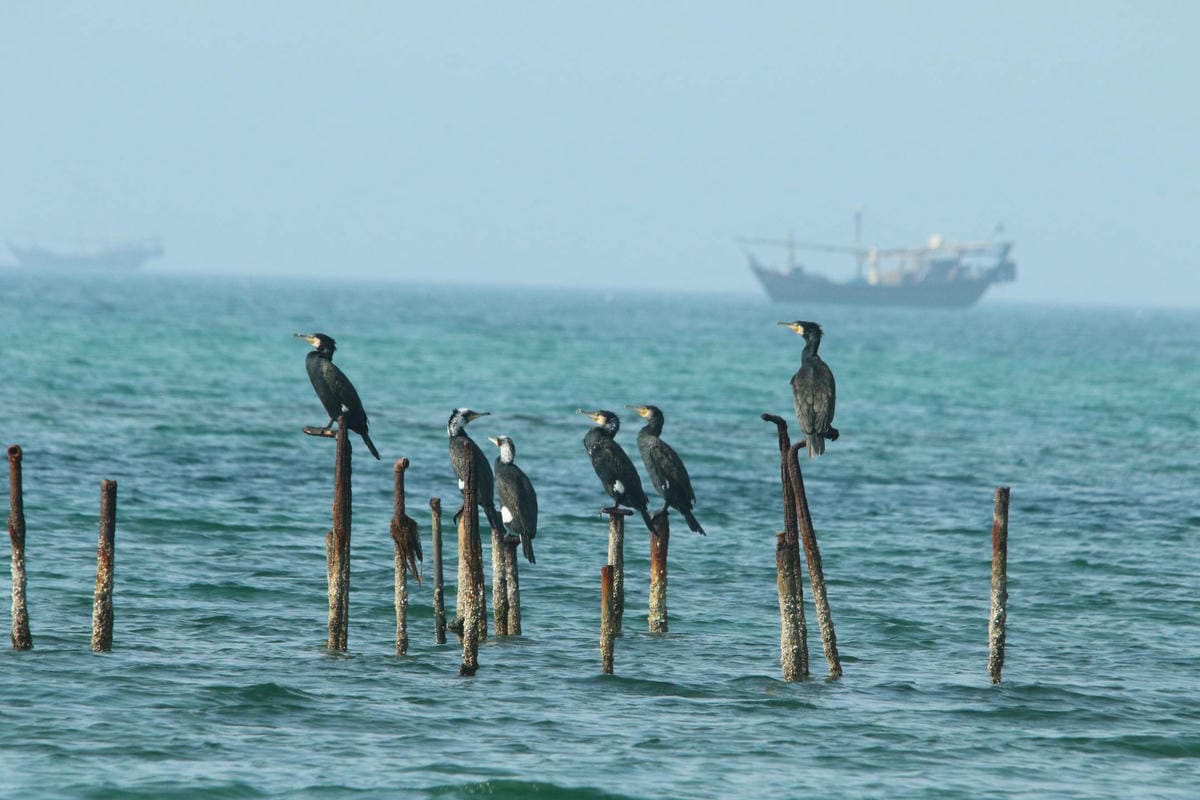
Jubail Marine protected area
The protected area is located inEastern Region
Total Area2,400 km²
IUCN categoryVI
Protected AreaThe protected area is north of Jubail Industrial City. Its land area is 760 km2, and its marine area is 1650 km2. The terrestrial part consists of bedrock outcrops, sand sheets, dunes, and sabkhahs, and wetlands. The intertidal zone is characterized by sandy beaches, mudflats, rocky shores, saltmarshes, and blue-green algal mats. The subtidal habitats include seagrass beds, macroalgal beds, and whip coral beds, and are significant fish and shrimp nurseries.
Notable plant speciesTerrestrial habitats harbor the golden jackal, Arabian red fox, desert and long-eared hedgehogs, trident bat, lesser jerboa, desert monitor lizard, spiny tailed dhabb, agamas, and migratory Asian houbara and falcons, as well as waders, crab-plovers, waterfowl, terns, gulls, and the Socotra cormorant. Marine species include humpback, common, and bottlenose dolphin, finless porpoise, sea turtles, sharks and rays, groupers and other bony fishes, and a wide diversity of sponges, sea urchins, starfishes, bivalves, sea snails, squids, cuttlefish, crabs, and shrimps.

Juzur Farasan
The protected area is located inJazan Region
Total Area5772km²
IUCN categoryVI
Protected AreaThe protected area is in the southern Red Sea, about 42 km from Jazan city. The Farasan Archipelago comprises more than 170 islands, of which the largest, Farasan al-Kabir and As-Saqid, are inhabited. The Farasan Islands harbor the richest combined marine and terrestrial biodiversity of all sites in Saudi Arabia. In 2021 the protected area became Saudi Arabia’s first Biosphere Reserve, and it is on the Kingdom’s tentative list of World Heritage sites.
Notable plant speciesApproximately 188 plant species have been documented within the reserve. The vegetation types include dense coastal thickets of the mangroves Avicennia marina and Rhizophora mucronata and seagrass meadows. Terrestrial plants include Vachellia flava, Ziziphus spina-christi, Salvadora persica, Commiphora gileadensis, and Aloe officinalis.
Notable animal speciesThe protected area holds the largest population of Arabian mountain gazelle in the Kingdom, as well as the white-tailed mongoose, pink-backed pelican, osprey, white-eyed gull, Goliath heron, crab plover, sooty falcon, Egyptian vulture, and the endemic sarso racer snake. Humpback and Bryde’s whales, dolphins, dugongs, and marine turtles abound in the sea along with a wide diversity of reef fishes, sharks and rays, corals, echinoderms, bivalves, sea snails, and crustaceans.